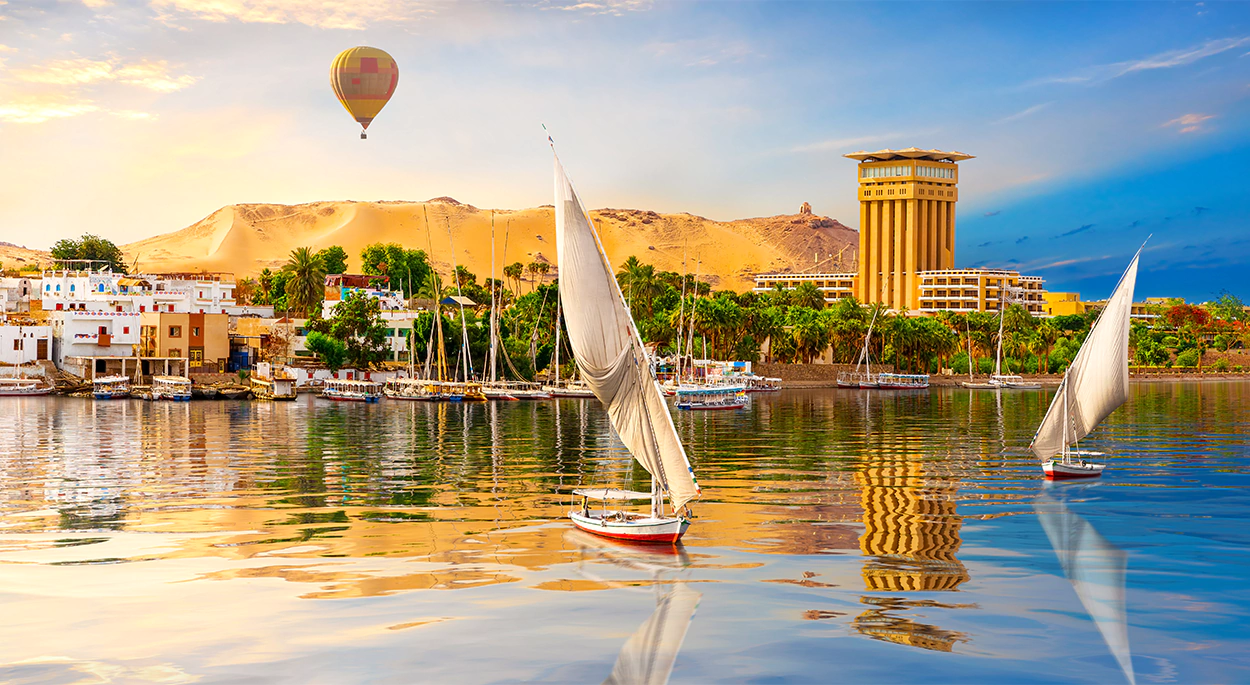
Known to many as the longest river in the world, the mighty Nile River, is also called the father of the African rivers. It rises south of the Equator and flows northward through the northeastern Africa up to the Mediterranean Sea. It stretches of about 6650 kilometers (4132 miles) and runs through or along the border ten other African countries namely, Burundi, Tanzania, Rwanda, the Democratic Republic of Congo, Kenya, Uganda, Sudan, Ethiopia, and South Sudan.
The Nile is formed by two major streams: the Blue Nile is the source of most water of the Nile downstream, containing 80% of the water and silt. It begins at Lake Tana in Ethiopia and flows into Sudan from the southeast. And the White Nile, is the longer and rises in the Great Lakes region. It flows from Lake Victoria and through Uganda and South Sudan.
Human settlement along the Nile dates back to around 5000 BCE. The fertile banks of the river provided sustenance for early agricultural communities, leading to the establishment of small villages and towns along the Nile. During the ancient Egyptian civilization, the Nile River is flooded annually, wherein it deposits nutrient-rich silts on the riverbanks, which started agriculture. It allowed ancient Egyptians to developed advanced irrigation systems and cultivate crops. This is where also the ideal growing location for papyrus plant. Ancient Egyptians used the papyrus plant in many ways such as making clothing, boxes, ropes and most importantly it was used in making paper. The Nile River also served as a vital transportation route for trade and communication between different regions of Egypt.

In today’s time, the Nile River attracts travelers from around the world thru river cruising. It’s the best way to experience the beauty and charm of the Nile while visiting different historical sites along its bank. Below some the historical sites that are located in the near the Nile River:
Pyramids of Giza & Sphinx: Located near Cairo, the Pyramids of Giza namely; the Great Pyramid of Khufu, the Pyramid of Khafre and the Pyramid of Menkaure and the Sphinx are iconic symbols of ancient Egypt.
Karnak Temple: A vast temple complex is one of the largest religious sites in the world, featuring temples, chapels, pylons and obelisks constructed over several centuries ago. Karnak Temple can be found in the east bank of the Nile River.
Luxor Temple: Situated also on the east bank of the Nile in Luxor, this temple complex was constructed during the New Kingdom period and is dedicated to the god Amun.
Valley of the Kings: A necropolis that is home to the tombs of many pharaohs and nobles of the New Kingdom, including the tomb of Tutankhamun. The Valley of the Kings is located in the west bank of the Nile River.
Temple of Dendera: Also known as the Temple of Hathor, the goddess Hathor is associated with love, music, dance and fertility in ancient Egyptian religion. It is considered as one of the best-preserved ancient Egyptian temples located near the modern city of Qena, about 60 Kilometers (37 miles) north of Luxor.
Temple of Medina Habu: Built during the reign of Pharaoh Ramesses III of the New Kingdom’s 20the dynasty in 12th century BCE. It served as both mortuary temple. Dedicated to the deified king after his death, and a fortress to protect the Theban necropolis.
Abydos Temple: This temple is located in Upper Egypt near the modern town of Al-Balyan. It is dedicated to the god of Osiris, the god of the afterlife, and it served as a center for pilgrimage and worship throughout ancient Egyptian history.
Temple of Kom Ombo: Temple of Kom Ombo is dedicated to two primary deities: Sobek, the crocodile-headed god associated with fertility and protection, and Horus the Elder, the falcon-headed god of kingship and the sky. The temple reflects a symmetrical design, with mirrored halls and sanctuaries dedicated to each god. This temple can be found in the Upper Egypt, near the town of Kom Ombo, about 45 Kilometers (28 miles) north of Aswan along the Nile River.
Edfu Temple: This temple is solely dedicated to the falcon-headed god Horus, and it was built during the Ptolemaic dynasty, between 237 and 57 BCE.
Aswan: A city in southern Egypt, is known to its flourishing history, stunning natural beauty and historical sites. The Philae Temple, is located on Agilkia Island in the Nile River. The temple is dedicated to the goddess Isis and it features beautiful reliefs, colonnades, and sanctuaries. It was relocated to its current location to save it from flooding caused by the construction of Aswan High Dam. Aswan High Dam was constructed in the 1960s until the 1970s, and considered as a monumental engineering project in the Nile River. The Unfinished Obelisk, is a colossal monolith left unfinished due to a crack in the rock. It was listed on the UNESCO World Heritage Site in 1979. Last site that can be visited in Aswan is the Nubian Museum that showcases the culture, history and art of the Nubian people this includes ancient artifacts, traditional Nubian crafts, Nubian heritage and customs.
Nubian Village: Also located in Aswan, the Nubian Village is a vibrant and traditional village along the banks of the Nile River. Here you can experience to interact with the friendly local and explore their colorful houses with intricate geometric patterns.
Elephantine Island: Another island located in the Nile River, and home to various archaeological sites, including Khnum, the ancient town of Yebu, and the Nilometer, a structure used to measure’s the Nile River’s water level.
Abu Simbel: An ancient temple complex located in the southern Egypt, near the border with Sudan. The Abu Simbel is famous for its monumental rock-cut temples, carved during the reign of Pharaoh Ramesses II in the 13th centure BCE. The main temple is dedicated to the god Amun, the god Ra-Horakhty, and the god Ptah. The smaller temple is dedicated to Ramesses II's wife, Queen Nefertari.